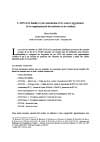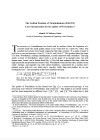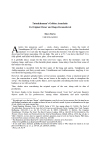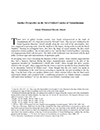ToutÃĒnkhamon
« LâADN de la famille royale amarnienne et les sources ÃĐgyptiennes. De la complÃĐmentaritÃĐ des mÃĐthodes et des rÃĐsultats »
ENiM 6, 2013, p. 177-203.
 Les enquÊtes menÃĐes sur lâADN des momies royales publiÃĐes en 2010 ont fourni des matÃĐriaux pour un nouvel arbre gÃĐnÃĐalogique de la famille royales de la fin de la XVIIIe dynastie. AprÃĻs avoir discutÃĐ de la fiabilitÃĐ de ces ÃĐtudes, un examen approfondi des rÃĐsultats conduit à la conclusion que certains liens de parentÃĐ rÃĐvÃĐlÃĐs par lâADN ont ÃĐchappÃĐ Ã lâÃĐquipe de gÃĐnÃĐticiens. Le plus significatif de ceux-ci consiste dans le fait que Youya partage avec son gendre Amenhotep III environ 1/3 de son patrimoine gÃĐnÃĐtique. Il est proposÃĐ, en consÃĐquence, que Youya ait ÃĐtÃĐ un oncle dâAmenhotep III, ce qui signifie que Tiyi ÃĐtait une cousine germaine de son mari. En extrapolant pour la gÃĐnÃĐration suivante, on suggÃĻre quâAmenhotep IV â Akhenaton a ÃĐgalement ÃĐpousÃĐe sa propre cousine, Nefertiti, dont les parents ÃĐtaient liÃĐes à la fois à Youya et Amenhotep III. Ceci expliquerait pourquoi lâADN dâAmenhotep IV â Akhenaton (momie de KV 55) et celui de Nefertiti, identifiÃĐe, à la Young Lady de la tombe dâAmenhotep II (KV35YL) aient pu sembler ceux dâun frÃĻre et dâune sÅur. En accord avec les tÃĐmoignages ÃĐcrits de nouveau examinÃĐs en dÃĐtail, Toutankhamon est considÃĐrÃĐ comme le septiÃĻme et dernier enfant dâAmenhotep IV â Akhenaton et Nefertiti et, de son cÃītÃĐ, la momie KV21A est donnÃĐe comme vraisemblablement celle de Moutemouiya. Un nouvel arbre gÃĐnÃĐalogique, fondÃĐ sur ces donnÃĐes ADN et ÃĐpigraphiques est proposÃĐ en conclusion.
Les enquÊtes menÃĐes sur lâADN des momies royales publiÃĐes en 2010 ont fourni des matÃĐriaux pour un nouvel arbre gÃĐnÃĐalogique de la famille royales de la fin de la XVIIIe dynastie. AprÃĻs avoir discutÃĐ de la fiabilitÃĐ de ces ÃĐtudes, un examen approfondi des rÃĐsultats conduit à la conclusion que certains liens de parentÃĐ rÃĐvÃĐlÃĐs par lâADN ont ÃĐchappÃĐ Ã lâÃĐquipe de gÃĐnÃĐticiens. Le plus significatif de ceux-ci consiste dans le fait que Youya partage avec son gendre Amenhotep III environ 1/3 de son patrimoine gÃĐnÃĐtique. Il est proposÃĐ, en consÃĐquence, que Youya ait ÃĐtÃĐ un oncle dâAmenhotep III, ce qui signifie que Tiyi ÃĐtait une cousine germaine de son mari. En extrapolant pour la gÃĐnÃĐration suivante, on suggÃĻre quâAmenhotep IV â Akhenaton a ÃĐgalement ÃĐpousÃĐe sa propre cousine, Nefertiti, dont les parents ÃĐtaient liÃĐes à la fois à Youya et Amenhotep III. Ceci expliquerait pourquoi lâADN dâAmenhotep IV â Akhenaton (momie de KV 55) et celui de Nefertiti, identifiÃĐe, à la Young Lady de la tombe dâAmenhotep II (KV35YL) aient pu sembler ceux dâun frÃĻre et dâune sÅur. En accord avec les tÃĐmoignages ÃĐcrits de nouveau examinÃĐs en dÃĐtail, Toutankhamon est considÃĐrÃĐ comme le septiÃĻme et dernier enfant dâAmenhotep IV â Akhenaton et Nefertiti et, de son cÃītÃĐ, la momie KV21A est donnÃĐe comme vraisemblablement celle de Moutemouiya. Un nouvel arbre gÃĐnÃĐalogique, fondÃĐ sur ces donnÃĐes ADN et ÃĐpigraphiques est proposÃĐ en conclusion.
 The investigations carried on the DNA of the royal mummies published in february 2010 have provided material for a new genealogical tree for the royal family of the late XVIIInth dynasty. After discussing the reliability of this study, a close examination of these results leads to the conclusion that some genetical links excaped to the team of geneticians. The most significant being the fact that Yuya shares with his son-in-law Amenhotep III about 1/3 of genetical inheritance. It is consequently proposed that Yuya was an uncle of Amenhotep III, Mutemwiya being his sister. This means that queen Tiyi was in fact an actual cousin of Amenhotep III. Extrapolating to the next generation it is also suggested that Amenhotep IV â Akhenaten equally married his own cousin, Nefertiti, whose parents were related to both Amenhotep III and Yuya. This would explain why the DNA of Amenhotep IV â Akhenaten (mummy KV 55) and that of Nefertiti, identified to mummy KV 35 YL, were looking like that of siblings. It is also suggested that Tutankhamun was the seventh child of Amenhotep IV â Akhenaten and Nefertiti in accordance with some reappraised epigraphic evidences, and that Mutemwiya is no other than the mummy KV21A. A new genealogical tree based on DNA and epigraphic data is given in conclusion.
The investigations carried on the DNA of the royal mummies published in february 2010 have provided material for a new genealogical tree for the royal family of the late XVIIInth dynasty. After discussing the reliability of this study, a close examination of these results leads to the conclusion that some genetical links excaped to the team of geneticians. The most significant being the fact that Yuya shares with his son-in-law Amenhotep III about 1/3 of genetical inheritance. It is consequently proposed that Yuya was an uncle of Amenhotep III, Mutemwiya being his sister. This means that queen Tiyi was in fact an actual cousin of Amenhotep III. Extrapolating to the next generation it is also suggested that Amenhotep IV â Akhenaten equally married his own cousin, Nefertiti, whose parents were related to both Amenhotep III and Yuya. This would explain why the DNA of Amenhotep IV â Akhenaten (mummy KV 55) and that of Nefertiti, identified to mummy KV 35 YL, were looking like that of siblings. It is also suggested that Tutankhamun was the seventh child of Amenhotep IV â Akhenaten and Nefertiti in accordance with some reappraised epigraphic evidences, and that Mutemwiya is no other than the mummy KV21A. A new genealogical tree based on DNA and epigraphic data is given in conclusion.
 Consulter cet article (47559) -
Consulter cet article (47559) -  Télécharger cet article au format pdf (24634)
Télécharger cet article au format pdf (24634)
« The Golden Pendant of Tutankhamun (JE61952). A new interpretation for the epithet of Werethekau »
ENiM 9, 2016, p. 1-4.
 Cet article propose une nouvelle lecture de lâÃĐpithÃĻte dâOurethÃĐkaou, dÃĐesse liÃĐe au couronnement, sur un pendentif en or du ToutÃĒnkhamon conservÃĐ au musÃĐe ÃĐgyptien du Caire (JE 61952), trouvÃĐ dans le petit naos dorÃĐ de ToutÃĒnkhamon. Lâarticle tente dâÃĐtablir la preuve, en comparant avec dâautres attestations de lâÃĐpithÃĻte, que lâÃĐpithÃĻte royale ÂŦ le bien-aimÃĐ de OurethÃĐkaou, dame de ciel Âŧ devrait plutÃīt Être lu ÂŦ le bien-aimÃĐ dâOurethÃĐkaou, dame du palais Âŧ.
Cet article propose une nouvelle lecture de lâÃĐpithÃĻte dâOurethÃĐkaou, dÃĐesse liÃĐe au couronnement, sur un pendentif en or du ToutÃĒnkhamon conservÃĐ au musÃĐe ÃĐgyptien du Caire (JE 61952), trouvÃĐ dans le petit naos dorÃĐ de ToutÃĒnkhamon. Lâarticle tente dâÃĐtablir la preuve, en comparant avec dâautres attestations de lâÃĐpithÃĻte, que lâÃĐpithÃĻte royale ÂŦ le bien-aimÃĐ de OurethÃĐkaou, dame de ciel Âŧ devrait plutÃīt Être lu ÂŦ le bien-aimÃĐ dâOurethÃĐkaou, dame du palais Âŧ.
 This article presents a new reading for the epithet of Werethekau, the goddess of coronation, on the golden pendant of Tutankhamun at Cairo Museum (JEÂ 61952). The epithet of Werethekau was found on a pendant within the small golden shrine of Tutankhamun. This paper will investigate the evidence whether one of the epithet of the king âbeloved of Werethekau, lady of heavenâ should instead be read as âbeloved of Werethekau, lady of the palaceâ through comparison with other known examples of the epithet.
This article presents a new reading for the epithet of Werethekau, the goddess of coronation, on the golden pendant of Tutankhamun at Cairo Museum (JEÂ 61952). The epithet of Werethekau was found on a pendant within the small golden shrine of Tutankhamun. This paper will investigate the evidence whether one of the epithet of the king âbeloved of Werethekau, lady of heavenâ should instead be read as âbeloved of Werethekau, lady of the palaceâ through comparison with other known examples of the epithet.
 Consulter cet article (44466) -
Consulter cet article (44466) -  Télécharger cet article au format pdf (20243)
Télécharger cet article au format pdf (20243)
« Tutankhamunâs Golden Armchair: Its Original Owner and Shape Reconsidered »
ENiM 14, 2021, p. 273-284.
 Il est gÃĐnÃĐralement admis que le fauteuil dorÃĐ lÃĐontocÃĐphale de la tombe de ToutÃĒnkhamon a ÃĐtÃĐ fabriquÃĐ pour ce roi, au dÃĐbut de son rÃĻgne. Cependant, certains auteurs, qui ont ÃĐtudiÃĐ la scÃĻne atonienne sur le dossier, pensent que le siÃĻge a appartenu à un prÃĐcÃĐdent roi amarnien. Dans cette ÃĐtude, nous proposons deux nouvelles analyses afin dâidentifier le propriÃĐtaire originel : le contexte typologique et lâiconographie globale. Ces deux approches nous permettent ÃĐgalement de reconsidÃĐrer la forme originelle du siÃĻge. Nous dÃĐmontrons ainsi que le fauteuil lÃĐontocÃĐphale de ToutÃĒnkhamon a appartenu à un prÃĐcÃĐdent roi, probablement Akhenaton, et quâil sâagissait dâune simple chaise lÃĐonine, typique de la pÃĐriode amarnienne.
Il est gÃĐnÃĐralement admis que le fauteuil dorÃĐ lÃĐontocÃĐphale de la tombe de ToutÃĒnkhamon a ÃĐtÃĐ fabriquÃĐ pour ce roi, au dÃĐbut de son rÃĻgne. Cependant, certains auteurs, qui ont ÃĐtudiÃĐ la scÃĻne atonienne sur le dossier, pensent que le siÃĻge a appartenu à un prÃĐcÃĐdent roi amarnien. Dans cette ÃĐtude, nous proposons deux nouvelles analyses afin dâidentifier le propriÃĐtaire originel : le contexte typologique et lâiconographie globale. Ces deux approches nous permettent ÃĐgalement de reconsidÃĐrer la forme originelle du siÃĻge. Nous dÃĐmontrons ainsi que le fauteuil lÃĐontocÃĐphale de ToutÃĒnkhamon a appartenu à un prÃĐcÃĐdent roi, probablement Akhenaton, et quâil sâagissait dâune simple chaise lÃĐonine, typique de la pÃĐriode amarnienne.
 It is often admitted that the lion-headed golden armchair from the tomb of Tutankhamun was made for this king, at the beginning of his reign. However, some authors, who studied the Atenist scene on the backrest, think the seat belonged to a previous Amarna king. In this study, we propose two more analyses in order to identify the original owner of the armchair: the typological context and the global iconography. These two approaches allow us to reconsider the original shape of the seat, too. We show that Tutankhamunâs lion-headed armchair belonged to a previous king, most probably Akhenaten, and that it was a simple lion-legged chair, typical of the Amarna period.
It is often admitted that the lion-headed golden armchair from the tomb of Tutankhamun was made for this king, at the beginning of his reign. However, some authors, who studied the Atenist scene on the backrest, think the seat belonged to a previous Amarna king. In this study, we propose two more analyses in order to identify the original owner of the armchair: the typological context and the global iconography. These two approaches allow us to reconsider the original shape of the seat, too. We show that Tutankhamunâs lion-headed armchair belonged to a previous king, most probably Akhenaten, and that it was a simple lion-legged chair, typical of the Amarna period.
 Consulter cet article (30510) -
Consulter cet article (30510) -  Télécharger cet article au format pdf (14655)
Télécharger cet article au format pdf (14655)
« Another Perspective on the Set of Gilded Couches of Tutankhamun »
ENiM 15, 2022, p. 217-232.
 Lâensemble des lits dorÃĐs dÃĐcouverts dans la tombe de ToutÃĒnkhamon est examinÃĐ afin de rÃĐinterprÃĐter leur rÃīle et leur identification. Cette ÃĐtude combine lâiconographie de la seconde chapelle dorÃĐe de ToutÃĒnkhamon et de sa chambre funÃĐraire, les scÃĻnes des livres du monde souterrain et lâobservation dÃĐtaillÃĐe des lits eux-mÊmes dans les laboratoires de restauration du Grand MusÃĐe ÃĐgyptien. Cela a permis dâidentifier la signification et la relation entre toutes ces scÃĻnes et les lits, ainsi que leur emplacement respectif dans la tombe elle-mÊme. Les lits participent au voyage de lâÃĒme du dÃĐfunt dans lâascension cÃĐleste.
L'ensemble comprend trois lits reprÃĐsentant chacun une lionne identifiÃĐe comme une reprÃĐsentation de lâÃĐtoile Orion (sAH), une vache comme lâÃĐtoile Sothis (Spdt), et un hippopotame femelle hybride identifiÃĐ comme une constellation du ciel borÃĐal. Ils sont associÃĐs respectivement à la renaissance dâOsiris et de RÊ dans les mythes ÃĐgyptiens, à partir du stade de lâunion du kA et du bA, du bA sÃĐparÃĐ, et du Ax.
Lâensemble des lits dorÃĐs dÃĐcouverts dans la tombe de ToutÃĒnkhamon est examinÃĐ afin de rÃĐinterprÃĐter leur rÃīle et leur identification. Cette ÃĐtude combine lâiconographie de la seconde chapelle dorÃĐe de ToutÃĒnkhamon et de sa chambre funÃĐraire, les scÃĻnes des livres du monde souterrain et lâobservation dÃĐtaillÃĐe des lits eux-mÊmes dans les laboratoires de restauration du Grand MusÃĐe ÃĐgyptien. Cela a permis dâidentifier la signification et la relation entre toutes ces scÃĻnes et les lits, ainsi que leur emplacement respectif dans la tombe elle-mÊme. Les lits participent au voyage de lâÃĒme du dÃĐfunt dans lâascension cÃĐleste.
L'ensemble comprend trois lits reprÃĐsentant chacun une lionne identifiÃĐe comme une reprÃĐsentation de lâÃĐtoile Orion (sAH), une vache comme lâÃĐtoile Sothis (Spdt), et un hippopotame femelle hybride identifiÃĐ comme une constellation du ciel borÃĐal. Ils sont associÃĐs respectivement à la renaissance dâOsiris et de RÊ dans les mythes ÃĐgyptiens, à partir du stade de lâunion du kA et du bA, du bA sÃĐparÃĐ, et du Ax.
 The set of gilded couches discovered in the tomb of Tutankhamun is examined to interpret their role and identification anew. This study combines the iconography of the Second gilded shrine of Tutankhamun and his burial chamber, scenes from the books of the netherworld dating throughout Egyptian history, and detailed observation of the couches themselves in the restoration laboratories of the Grand Egyptian Museum. This resulted in identifying the meaning and relationship among all these scenes and the couches, as well as their respective placement in the tomb itself. The couches participate in this narrative by representing the journey of the deceasedâs soul in the heavenly ascension.
The set comprises three couches representing a lioness identified as a representation of the star Orion (sAH), a cow as the star Sothis (Spdt), and a hybrid female hippopotamus identified as a constellation in the northern sky. They are associated with the rebirth of Osiris and Ra in the Egyptian myths, from the stage of the union of the kA and the bA, the bA separated, and the Ax, respectively.
The set of gilded couches discovered in the tomb of Tutankhamun is examined to interpret their role and identification anew. This study combines the iconography of the Second gilded shrine of Tutankhamun and his burial chamber, scenes from the books of the netherworld dating throughout Egyptian history, and detailed observation of the couches themselves in the restoration laboratories of the Grand Egyptian Museum. This resulted in identifying the meaning and relationship among all these scenes and the couches, as well as their respective placement in the tomb itself. The couches participate in this narrative by representing the journey of the deceasedâs soul in the heavenly ascension.
The set comprises three couches representing a lioness identified as a representation of the star Orion (sAH), a cow as the star Sothis (Spdt), and a hybrid female hippopotamus identified as a constellation in the northern sky. They are associated with the rebirth of Osiris and Ra in the Egyptian myths, from the stage of the union of the kA and the bA, the bA separated, and the Ax, respectively.
 Consulter cet article (27035) -
Consulter cet article (27035) -  Télécharger cet article au format pdf (11631)
Télécharger cet article au format pdf (11631)
ENiM 18 - 2025
4 article(s) - 11 mars 2025.
ENiM 1 à 18 (2008-2025) : 223 articles
4 022 205 téléchargements
8 339 554 consulations.
Index des auteurs

Mots clés

Derniers articles : 
Robert Steven Bianchi
Duplication and Continuity
(ENiM 18, p. 13-36 — 11 mars 2025) 
FrÃĐdÃĐric Mougenot
RÃĐnÃĐnoutet à la porte de la maison
(ENiM 18, p. 1-12 — 29 janvier 2025) 
CENiM - Mise en ligne des volumes ÃĐpuisÃĐs : 
 Anne-Sophie von BOMHARD DÃĐcans ÃĐgyptiens, CENiM 23, Montpellier, 2020 — (2020)
Anne-Sophie von BOMHARD DÃĐcans ÃĐgyptiens, CENiM 23, Montpellier, 2020 — (2020) 
 Jean-Claude Grenier L'Osiris ANTINOOS, CENiM 1, Montpellier, 2008 — (26 dÃĐcembre 2008)
Jean-Claude Grenier L'Osiris ANTINOOS, CENiM 1, Montpellier, 2008 — (26 dÃĐcembre 2008) 
TDENiM - Mise en ligne des volumes ÃĐpuisÃĐs : 
 Twitter
Twitter 3617112 visites - 7946 visite(s) aujourd’hui - 128 connecté(s)
© ENiM - Une revue d’égyptologie sur internet
Équipe Égypte Nilotique et Méditerranéenne - UMR 5140 - « Archéologie des Sociétés Méditerranéennes » (Cnrs) - Université Paul Valéry - Montpellier III

























 Contact
Contact
 Abonnez-vous !
Abonnez-vous ! Équipe Égypte Nilotique et Méditerranéenne
Équipe Égypte Nilotique et Méditerranéenne UMR 5140 « Archéologie des Sociétés Méditerranéennes » (Cnrs)
UMR 5140 « Archéologie des Sociétés Méditerranéennes » (Cnrs) Université Paul Valéry - Montpellier III
Université Paul Valéry - Montpellier III